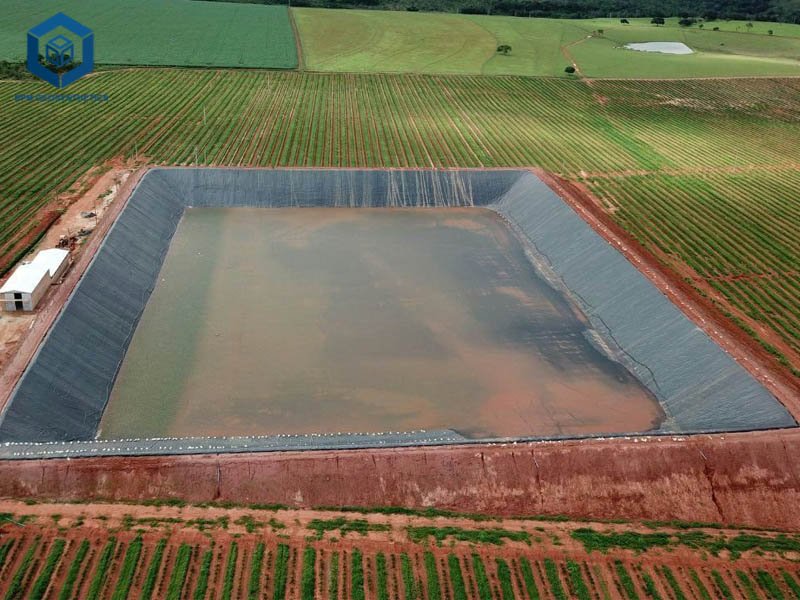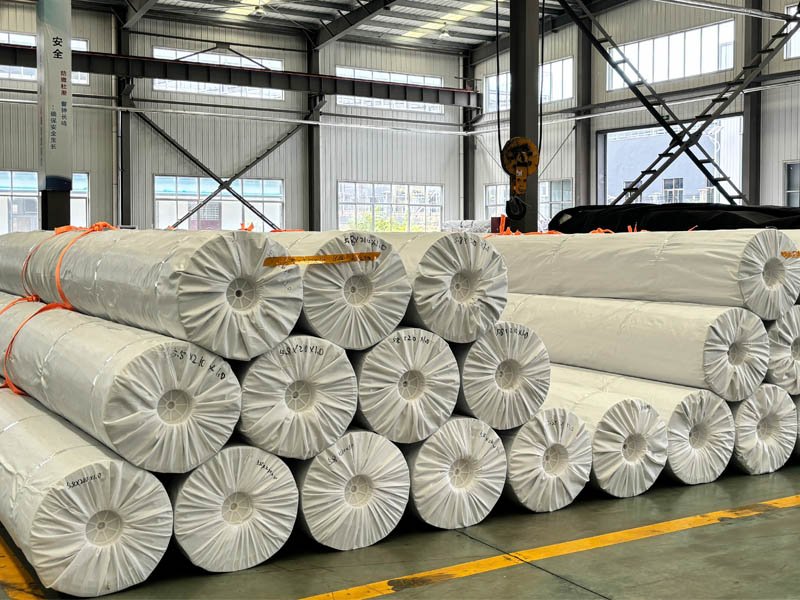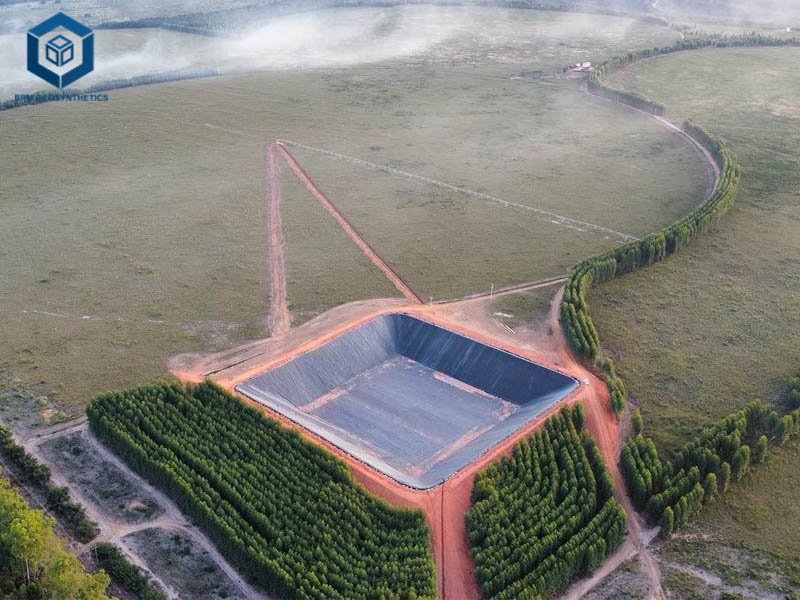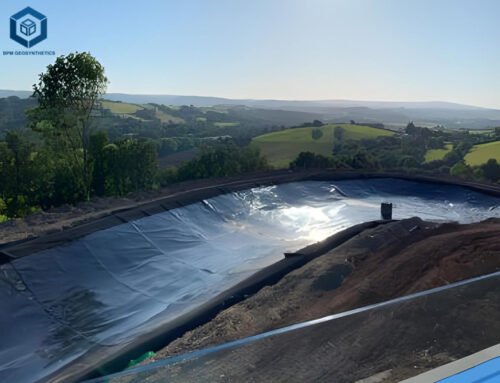High-Density Polyethylene (HDPE) impermeable liner, a premium geomembrane material, is widely used in containment applications for its exceptional chemical resistance, durability, and impermeability. Manufactured from high-density polyethylene resin, it effectively prevents the leakage of liquids, gases, or contaminants in environmental and engineering projects such as landfills, mining, and water conservation. BPM Geosynthetics, a leading manufacturer and supplier, specializes in producing high-quality HDPE liners with advanced UV resistance, tensile strength, and puncture resistance, ensuring long-term performance in harsh conditions. Their products meet international standards like ASTM and GRI, offering reliable solutions for geotechnical, hydraulic, and environmental protection projects. BPM Geosynthetics provides customized HDPE Impermeable Liner options, including smooth and textured surfaces, to meet diverse project requirements while ensuring cost-effectiveness and sustainability.
1. What Is HDPE Impermeable Liner?
1.1 Raw Materials
HDPE liners are primarily made from:
- High-Density Polyethylene (HDPE) Resin – A thermoplastic polymer derived from petroleum with high strength-to-density ratio.
- Carbon Black (2-3%) – Added for UV resistance and durability.
- Additives (e.g., antioxidants, stabilizers) – Enhance flexibility, longevity, and resistance to environmental stress cracking.
1.2 Production Process
HDPE geomembranes are manufactured through extrusion and calendering:
1.2.1 Resin Mixing & Melting
- HDPE pellets are blended with carbon black and additives.
- The mixture is melted in an extruder at high temperatures (~200°C).
1.2.2 Sheet Formation (Flat Die or Blown Film Extrusion)
- Flat Die Extrusion: Melted polymer is pressed through a flat die to form a continuous sheet.
- Calendering: The sheet is rolled to achieve uniform thickness (typically 0.5mm to 3mm).
1.2.3 Cooling & Cutting
- The hot sheet is cooled in water baths or via air cooling.
- It is then trimmed to desired widths (2m to 8m) and rolled for transportation.
1.2.4 Quality Testing
- Tensile strength, puncture resistance, and permeability tests ensure compliance with standards (e.g., GRI-GM13, ASTM D6392).


2. What Are The Advantages and Functions of HDPE Impermeable Liner?
2.1 Key Advantages of HDPE Impermeable Liner
- Excellent Chemical Resistance – Resists acids, alkalis, oils, and solvents.
- High Impermeability – Extremely low permeability (≤1×10⁻¹³ cm/s) prevents leakage.
- UV & Weather Resistance – Carbon black protects against sunlight degradation.
- Durability – Long service life (15-45+ years) even in harsh environments.
- Puncture & Tear Resistance – High tensile strength (≥20 MPa) prevents damage.
- Cost-Effective – Lower long-term maintenance costs compared to alternatives like PVC or clay.
2.2 What are the Primary Functions of HDPE Impermeable Liner?
High-Density Polyethylene (HDPE) impermeable liners serve three critical functions in environmental and industrial applications: containment, separation, and protection. These geomembranes are engineered to address modern challenges of pollution control, waste management, and infrastructure preservation.
2.2.1 The Containment Function of HDPE Liners
High-Density polyethylene (HDPE) impermeable liners excel in containment, forming robust barriers that prevent hazardous pollutants from leaching into soil and groundwater. This critical function is indispensable in landfills, mining operations, and wastewater treatment facilities, where secure confinement of toxic substances is essential for environmental protection and regulatory compliance.
2.2.2 The Separation Role in Environmental Protection
HDPE liners serve as effective separators, isolating waste materials from surrounding ecosystems to prevent cross-contamination. By maintaining distinct layers in landfills, ponds, and industrial sites, they ensure long-term environmental integrity and adherence to strict waste management standards.
2.2.3 Protective Qualities for Infrastructure Durability
Beyond containment and separation, HDPE liners provide vital protection against chemical corrosion, extreme weather, and mechanical stress. Their high resistance to degradation makes them ideal for secondary containment systems, agricultural storage, and industrial applications where structural longevity is crucial.
2.2.4 A Versatile Solution for Modern Challenges
Combining containment, separation, and protection, HDPE liners offer a comprehensive solution for pollution control and infrastructure preservation. Their durability, chemical resistance, and impermeability make them the preferred choice for engineers and environmentalists tackling complex containment challenges while ensuring sustainability and safety.
3. What are the applications of HDPE Impermeable Liner?
High-density polyethylene (HDPE) impermeable liners serve critical containment functions across multiple industries due to their exceptional durability and chemical resistance. These versatile geomembranes find extensive application in four primary sectors: environmental protection, water management, mining/industrial operations, and agriculture.
3.1 HDPE Impermeable Liner – Environmental Protection Applications
HDPE impermeable liners play a vital role in environmental protection, serving as essential barriers in landfills to prevent leachate contamination of soil and groundwater. They are equally crucial in wastewater treatment lagoons and hazardous waste containment systems, where their superior chemical resistance ensures safe isolation of pollutants, meeting strict environmental regulations.
3.2 HDPE Impermeable Liner – Water Management Solutions
In water conservation and management, HDPE liners are widely used in reservoirs, ponds, and canals to prevent seepage and maintain water levels. The aquaculture industry relies on them to preserve water quality, while decorative water features in urban and residential areas benefit from their durability and aesthetic adaptability.
3.3 HDPE Impermeable Liner – Mining and Industrial Containment
Mining operations utilize HDPE liners in heap leach pads to safely contain chemical solutions during metal extraction. The oil and gas sector depends on them for spill containment, while industrial facilities install them as secondary containment under storage tanks, preventing leaks from causing environmental harm.
3.4 HDPE Impermeable Liner – Agricultural and Renewable Energy Uses
Agriculture increasingly adopts HDPE liners for irrigation ponds, enhancing water efficiency. They are also integral to biogas digesters, creating gas-tight systems that optimize methane capture from organic waste. Their UV resistance, flexibility, and long lifespan (20-50 years) make them a sustainable choice for modern farming and renewable energy projects.


4. Are HDPE liners Recyclable or Eco-friendly at The End of Their Lifespan?
HDPE liners are technically recyclable but face practical challenges in becoming truly eco-friendly. While HDPE (High-Density Polyethylene) is a thermoplastic that can be melted and reprocessed into new products like plastic lumber or recycled geomembranes, contamination from hazardous residues, material degradation, and limited recycling infrastructure often hinder the process.
Despite these challenges, HDPE liners offer significant environmental benefits during their use. They have a long lifespan (20-50+ years), preventing pollutants from leaching into soil and water and reducing the need for frequent replacements. However, improper disposal can lead to microplastic pollution, and their fossil fuel dependency remains a concern.
To enhance sustainability, choosing liners with recycled content, designing for easier recycling, and partnering with specialized recyclers can make a difference. Proper end-of-life management is crucial to minimize environmental impact and maximize the eco-friendliness of HDPE liners
5. Summary
High-Density Polyethylene (HDPE) impermeable liners are engineered geomembranes offering superior containment, separation, and protection in environmental and industrial applications. Manufactured with high-grade HDPE resin, carbon black, and stabilizers, these durable liners (0.5-3mm thick) feature exceptional chemical resistance and longevity (20-50 years). BPM Geosynthetics specializes in producing premium HDPE liners for landfills, mining, wastewater treatment, and agricultural storage, meeting ASTM/GRI standards with advanced UV/puncture resistance. Their liners provide reliable fluid containment (permeability ≤1×10⁻¹³ cm/s) while outperforming alternatives like PVC in durability and installation flexibility. Though recycling challenges exist, BPM’s HDPE liners remain an eco-conscious solution through extended service life and effective pollution prevention. Proper installation with welded seams ensures optimal performance, making BPM’s products a cost-effective choice for long-term containment needs.





